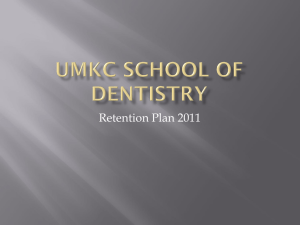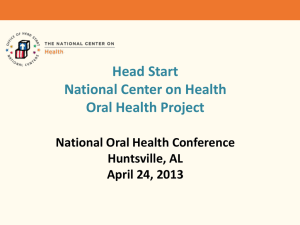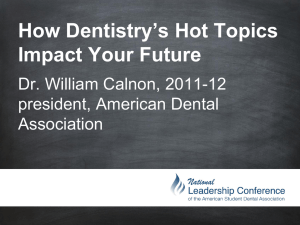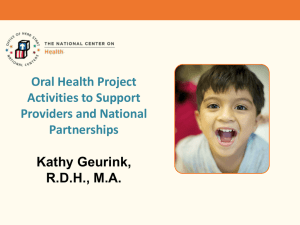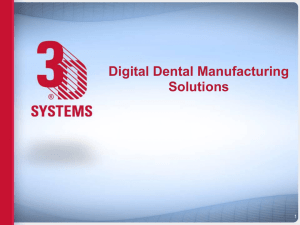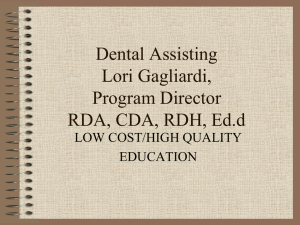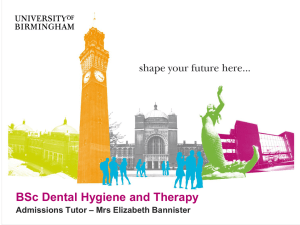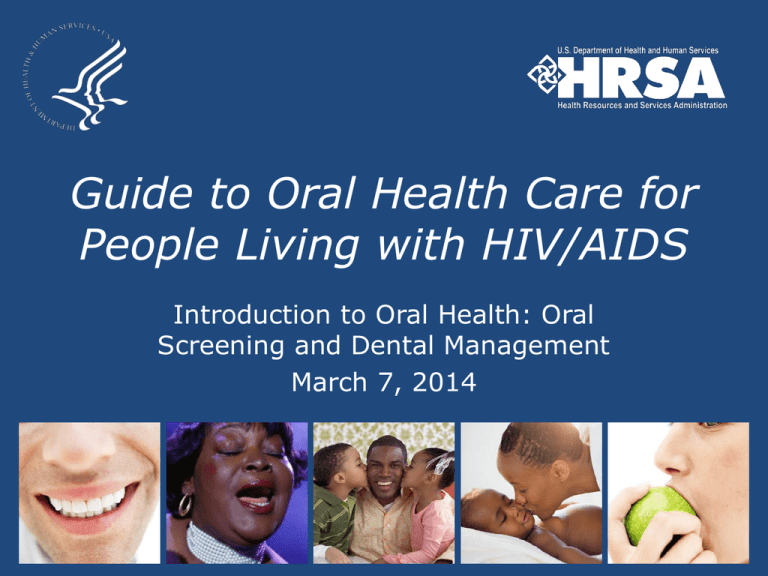
Guide to Oral Health Care for
People Living with HIV/AIDS
Introduction to Oral Health: Oral
Screening and Dental Management
March 7, 2014
Introduction
• HRSA/HAB sponsored curriculum designed to assist
primary care providers to recognize and manage oral
health and disease for people living with HIV/AIDS.
• Benefits of oral health integration in primary care:
–
–
–
–
Improve earlier linkage to oral health care
Reduce avoidable complications including oral-systemic
Reduce burden/costs of preventable diseases
Improve OH literacy of health care professionals and public
• Webinar series
– Chapters 1-2: March 7, 2-4 PM ET
– Chapters 3-5: March 28, 2-4 PM ET
• Webcasts on TARGET Center:
(https://careacttarget.org)
2
Housekeeping
• Everyone is in listen only mode
• Q&A will be taken during designated
breaks through presentation
– Questions will be handled via chat pod or
operator assistance
• Video streaming issues
• If you are viewing the webinar in a group,
please provide the total number of people
viewing the webinar in the appropriate
pod.
3
Guide to Oral Health Care for
People Living with HIV/AIDS
Chapter 1: Oral Health
Chapter 1:
• Course Authors:
– Jeffery D. Hill, D.M.D.
– Lauren L. Patton, D.D.S.
– Theresa G. Mayfield, D.M.D.
• Consultants:
– Vincent C. Marconi, M.D.
• Series Editor:
– David A. Reznik, D.D.S.
• HRSA, HIV/AIDS Bureau consultant:
– Mahyar Mofidi, D.M.D., Ph.D.
5
Chapter 1: Oral Health
• Educational Objectives
Answer the question “What is oral health?”
Discuss the importance of oral health
Review the burden of oral disease
Recognize the appearance of healthy
normal oral anatomy and common variants
of normal
– Learn a systematic approach to an efficient
oral screening technique
–
–
–
–
6
Goals of Oral Screening in the
Primary Care Setting
•
Assess the oral cavity for the presence of diseases
–
–
–
–
•
Dental caries and periodontal diseases
Mucosal diseases
Oral and oropharyngeal cancers
Acute infections
Enhance access to oral health care
– Prompt referral for management of acute care needs
and pathology
– Referral for prevention and maintenance of oral health
– Facilitate communication between the medical and
dental team
– Promote patient oral health literacy
– Recognize importance of oral health to overall health
– Encourage prevention and self-care
7
What is Oral Health?
• The health of the mouth and craniofacial (skull
and face) structures.
• Freedom from oral and craniofacial diseases and
conditions such as:
–
–
–
–
–
Dental caries
Periodontal diseases
Cleft lip and palate
Oral and facial pain
Oral and oropharyngeal cancers
• Among patients with HIV/AIDS, freedom from
other oral mucosal disease, such as oral
candidiasis, herpetic ulcers, oral warts, and
salivary gland disorders.
8
Importance of Oral Health
• “While good oral health is important to the
well-being of all population groups, it is
especially critical for people living with
HIV/AIDS (PLWHA). Inadequate oral
health care can undermine HIV treatment
and diminish quality of life, yet many
individuals living with HIV are not
receiving the necessary oral health care
that would optimize their treatment.”
-U.S. Public Health Service Surgeon
General Regina M. Benjamin, MD, MBA
9
Importance of Oral Health
• Good oral health:
Improves our ability to perform functions that
represent the very essence of our humanity:
•
•
•
•
•
Speak and smile
Smell and taste
Touch and kiss
Chew and swallow
Make facial expressions to show feelings and
emotions
Allows us to avoid pain and disability caused
by oral diseases
Provides protection against microbial infections
and environmental insults
10
Burden of Oral Disease
• Dental Caries
– 32% of US adults with ≤ high school education have untreated
dental caries
• Periodontal Disease
– 47% of US adults ≥ 30 years have mild to severe periodontitis
• Mucosal Disease
– 36% of HIV-infected adults on HAART experienced ≥ 1 oral lesion
over 2 years follow-up
– 41,380 new oral and pharyngeal cancers expected in 2013
• Disorders of the Craniofacial Complex
• Impact of oral diseases:
–
–
–
–
Jeopardizes general health and increases morbidity and mortality
Restricts activity in school, work and home
Significantly diminishes quality of life
Creates an economic burden for individual, family and society
11
Elements of the Mouth
• Teeth, gingiva and supporting connective tissues,
ligaments and bone
• Hard and soft palate
• Soft mucosal tissue lining the mouth and throat
• Tongue
• Lips
• Muscles of mastication
• Salivary glands
• Upper and lower jaws connected with the skull by
the temporomandibular joint
12
Extraoral and Intraoral Examination
• Extraoral Examination
– Inspection of face, head and neck:
• Facial contour and symmetry
• Changes on the skin
• Preauricular, submandibular, anterior cervical, posterior
auricular, and posterior cervical lymph nodes
• Muscles of mastication
• Salivary glands
• Temporomandibular joint
• Intraoral Examination
– Inspection of the internal mouth structures:
• Teeth, gingiva, and supporting connective tissues,
ligaments and bone
• Hard and soft palate
• Soft tissues lining the mouth and throat
• Tongue
• Lips
13
Systematic Approach to the Oral
Screening
• Armamentarium
– Gloves
– Light source
• Exam light
• Otoscope light
• Pen light
– 2x2 gauze
– Tongue depressor
• Disposable dental
mirror
• Techniques
– Visual inspection
– Bidigital palpation
• Gently squeeze
between thumb &
forefinger
– Compression
• Gently press against
bone with forefinger
• Allow 3-5 minutes for
complete exam
14
Lips
• Shape, color, texture
– symmetry
• Labial commissures
– corners of the mouth
• Vermillion border
– junction of facial skin
and lip mucosa
• Wet/dry line
– junction of inner and
outer lip mucosa
15
Lips and labial mucosa
• Bidigital palpation
– firm but pliable
– slightly nodular
• minor salivary glands
16
Labial mucosa and vestibule
• Labial frena
– maxillary frenum
– mandibular frenum
• Reflect lips
– smooth, glistening,
moist
– vascular
17
Mucogingival junction
• Keratinized tissue, often
“bound” to bone and less
vascular in appearance in
healthy tissue
− Gingiva
− Hard palate
• Non-keratinized tissue,
“non-bound” to bone
and more vascular in
appearance
− Buccal mucosa
− Soft palate
− Floor of mouth
18
Buccal mucosa
• Color, texture
– pink, smooth, moist
19
Buccal mucosa and vestibule
• Parotid gland
– palpate to check for
• tenderness
• firm nodules
• Stensen’s duct
– opposite maxillary
2nd molar
– gently depress to
check salivary flow
20
Palatal mucosa
• Hard palate
– pink, firm
– thick keratinized tissue
– pinpoint red macules
• minor salivary glands
• Soft palate
– pinkish-orange, movable
– thin non-keratinized
tissue
21
Anterior palatal mucosa
• Rugae
– firm ridges in anterior
hard palate
• Incisive papilla
– between maxillary
central incisors
22
Dorsal tongue
• Median lingual sulcus
• Covered with papillae
• Consistently firm and
pliable
23
Ventral & lateral tongue
• Ventral
– very thin mucosa
– lingual veins (a)
– lingual frenum (b)
• Lateral
– note normal vertical
“striped” appearance
along border
24
Floor of mouth
• Very thin mucosa
• Lingual frenum
• Lingual caruncles
– Wharton’s duct
• Submandibular
glands
– Duct of Bartholin
• Sublingual glands
25
Gingiva
• Pink, firm, stippled
– knife-edged margins
• gingiva lies flat against
the tooth
– pointed interdental
papillae
• fills space between teeth
• Normal physiologic
melanin pigmentation
26
Teeth
• 32 adult permanent
– molars, pre-molars, canines,
incisors
• Variations in color
– white, yellow, gray
• Check for
– plaque
• soft deposits of bacteria
& food debris
– calculus
• hard calcified deposits of
plaque and mineral salts
from saliva
– decayed, missing teeth
– tooth mobility
27
Common normal variations (1)
a
b
c
28
Common lesions & normal variations
• Mucocele (a)
– clear to bluish translucency
– mucous cyst caused by
rupture or obstruction of
minor salivary gland duct
• Irritation fibroma (b)
– pink, same as surrounding
tissue
– benign proliferation of
dense fibrous tissue
• Fordyce granules (c)
– yellowish-white
– ectopic sebaceous glands
29
Common normal variations (2)
a. fissured or scrotal tongue
(below)
b. facial surfaces (top right)
and lingual surfaces (bottom
right) with plaque & calculus
30
Oral health screening video
31
Questions?
32
Guide to Oral Health Care for
People Living with HIV/AIDS
Chapter 2: Dental Management
Chapter 2: Dental Management
• Course Author:
– Lauren L. Patton, D.D.S.
• Consultant:
– Vincent C. Marconi, M.D.
• Series Editor:
– David A. Reznik, D.D.S.
• HRSA, HIV/AIDS Bureau Consultant:
– Mahyar Mofidi, D.M.D, Ph.D.
34
Chapter 2: Learning Objectives
• Educational Objectives
– Discuss oral-systemic connections
in PLWHA
– Recognize the role of the primary care
clinician in promoting oral health
– Describe the elements of effective
medical-dental collaboration and effective
dental referral
• Standardized format for making referrals
• Describe required labs needed by dental
team
• Dental management concerns of dentists
(bleeding and infections)
• Providing feedback to referring primary
care provider
35
Oral-Systemic Connections in
People Living with HIV/AIDS
• Oral health is critical for overall
health and psychological well-being.
• The mouth is a mirror of health or
disease.
– Mucosa
– Saliva
• Emerging evidence suggests both:
– non-HIV oral pathogens may
undermine HAART success, with
periodontal disease exacerbating HIV
viremia
– chronic untreated HIV disease may
contribute to the acceleration of ageappropriate periodontal disease
36
Impact of Patient Lifestyle Behaviors
• Tobacco
– Lung cancers and heart disease
– Oropharyngeal cancer, oral candidiasis, periodontal disease
– Smoking is the major modifiable death risk factor for PLWHA
• Alcohol
– Liver disease
– Oropharyngeal cancer
• Recreational Drugs
– Poor nutrition and hygiene, blood-borne infections
– Poor oral hygiene, rampant dental caries
(meth mouth)
• Poor Dietary Habits
– Faster HIV disease progression
– More dental caries and tooth loss
37
Antiretroviral Drug Effects on the
Oral and Facial Region
• Xerostomia
– Decreased saliva increases
risk of dental caries and
candida infections
• Fat redistribution
– Facial fat wasting and
parotid lipomatosis
• Taste disturbances
• Oral and perioral
paresthesias
38
Spread of Oral Infections
• Bacteria (oral β streptococci and other
species from dental abscesses or
periodontal collections):
– Spread locally, regionally or distantly
for extension
• Intraoral abscess, sinusitis, facial and
periorbital cellulitis, submandibular or
retropharyngeal abscess and airway
compromise, or brain abscesses
– Aspiration pneumonia
– Bacteremia and possible distant site
infection, infective endocarditis
• Fungus (Candida): oral to esophagus
• Virus (HSV, HPV): oral to genital;
oral to anal
39
Role of the Primary Care Clinician
in Promoting Oral Health
• Screening/detection of oral disease
– History, risk assessment, examination
• Coaching for oral disease risk avoidance and
promoting oral hygiene practices
• Evaluate and initially manage acute dental
disease
• Referral to a dentist for acute/chronic dental
disease ongoing medical, surgical, restorative or
rehabilitative management
• Monitoring for disease progress or having
obtained dental treatment intervention
40
Oral Disease Screening/Detection
•
Symptomatic (may have chief complaint)
– Toothache/mouth pain
– Missing teeth
– Gum bleeding
– Growth or ulcer
– Swellings
– Difficulty eating or swallowing
• Asymptomatic (observed on oral exam)
–
–
–
Inflamed gums
White or red/purple patches or ulcers/growths
Blackened or broken teeth
41
Oral Disease Prevention
• Mechanical/Behavioral:
– Diet control: limit sugary, sticky food and
drinks
– Tobacco avoidance and limiting alcohol use
– Brushing teeth twice a day for 2 minutes
– Flossing once daily
– Brushing the top of the tongue
– Use of a fluoride containing toothpaste
– Avoid excessively abrasive toothpastes
– Reserve tooth whitening until oral health is
established
42
Dental Caries and Gingivitis Prevention
• Medications:
– Decay prevention: fluorides
• Prescription strength brush-on gel/paste- e.g. 1.1%
NaF Prevident® gel or Prevident ® 5000 plus paste
[apply small amount to brush and brush for 2
Rx NaF
minutes once daily; spit out excess]
gel/paste
• 0.4% Stannous fluoride gel (OTC but often stored
under the counter)- e.g. Gel-Kam® or Flo-Gel®
SnFL gel OTC
apply small amount to brush and brush for 2 minutes
once daily; spit out excess]
Fl mouthrinse
• Anticavity fluoride mouthrinses- e.g. ACT® (OTC),
Fluorigard ® (OTC) [10ml rinse and spit]
toothpaste
• OTC toothpaste
Lower risk
Higher risk
– Gingivitis prevention:
• antibacterial mouth rinses- e.g. 0.12% chlorhexidine
[1/2 oz rinse and spit BID]
43
Elements of Effective MedicalDental Collaborations
• Common areas
– Medically complicated
patients
– Bleeding-prone patients
– Patients at risk for
infections
– Anxious patients
44
Guidelines for Antibiotic Prophylaxis
Prior to Dental Treatment
Guidelines Addressing at Risk
Medical Conditions
Prior infective endocarditis, prosthetic
heart valve, congenital heart disease
(only 3 specific indications), cardiac
transplantation recipients who
develop cardiac valvulopathy (AHA
2007)
Orthopedic implant (total joint
replacements) (AAOS/ADA 2013)
Recommended
Consider
Not
recommended
X
X
Cardiovascular implantable electronic
device (AHA 2011)
X
Nonvalvular cardiovascular devices.
e.g. pacemakers, defibrillators, LVADs,
ventriculoatrial shunt, peripheral
vascular stents, vascular graphs
including hemodialysis, coronary
artery stents, venal caval filters,
intracardiac or arterial patches (AHA
2003)
X
45
Management of Bleeding For Patients on
Anticoagulant and Antiplatelet Agents
• Warfarin: For general dental procedures, no modification
needed; single tooth extractions can be done with INR<3.5
with local hemostatics; for complex elective surgery,
warfarin may need to be discontinued at least 24 hours in
advance. A presurgical treatment INR should be obtained.
• Low molecular weight heparins: no need to discontinue for
routine dental care; hold am dose only for surgical
procedures.
• Plavix and Aspirin: no need to discontinue.
• Dabigatran/rivaroxaban: no need to discontinue
for routine dental care; for complex elective surgery,
drug may need to be discontinued at least 24 hours
in advance.
• Primary closure and use of adjunctive local hemostatic
measures is recommended for surgical procedures in
bleeding prone patients when possible.
46
Unmet Need and Barriers to Oral Care
• Barriers to oral care
– Cost, access to dental care, fear of dental
care, indifference to dental care, logistical
issues such as transportation, language
and cultural barriers
• Concerns about HIV status
− disclosure/privacy, long delays before
appointments and long waiting room times
• For children with HIV
– poor interpersonal communication
between dental staff and caregiver/child
– shame/anger and family illness
– caregiver dental fear and low
prioritization of dental care
47
Oral Healthcare Access Barriers
– Low motivation or lack of awareness of
importance of oral health
– Dental anxiety and fear
– Shortage of dentists trained and willing to treat
patients with HIV/AIDS
– Lack of dental insurance coverage
– Limited financial resources
– Declining levels of adult dental Medicaid coverage
48
Overcoming Financial Access Limitations
– Oral Health Programs supporting dental care
services for PLWHA:
• HRSA Ryan White HIV/AIDS Program Dental
Reimbursement Program to dental educational
programs
• HRSA Ryan White HIV/AIDS Program CommunityBased Dental Partnership Program
• Dental programs funded through other parts of the
Ryan White HIV/AIDS Program
– Other lower cost dental care options:
• County health department or federally qualified health
center with dental clinic
• Dental school or hospital dental residency clinic
• Community-based free dental health clinic projects
– Other dental resources: contact state dental society
49
General Dentist
• Most referrals should be to a general
dentist convenient to the patient.
• Role:
– Assess risk, diagnose existing oral
disease/conditions, encourage disease
prevention.
– Establish dental treatment plan in
consultation with the patient and when
complexities exist, consultation and/or
coordination with the primary care
provider.
– Plan may involve referral of components
of care to dental specialists.
– Dental recall (recare) appointment
interval of 3-12 months established.
50
Elements of an Effective Dental Referral
•
How (does the referring dental office receive referrals? Fax, phone,
letter, electronic. Ask and follow their format and process.)
•
Who (patient information including age, contact information,
medical information; do include HIV infection along with other
medical conditions and past history of medical/surgical care)
•
Why (for specific issue/concern such as toothache with abscess,
missing teeth so can’t chew, purple lesion needing biopsy, broken
teeth needing repair, bleeding gums/bad breath from periodontal
disease, oral growth to r/o cancer)
•
What (consultation only, consult and treat)
•
When (emergency, urgency, routine)
•
Referred by: referring primary care provider’s name and office
contact information
51
Standardized Format for Making
Dental Referrals
• Consult/evaluation only vs. dental assessment and
treatment
• Patient’s and/or physician’s specific oral health concerns
– Upcoming medical/surgical treatment
• Patient contact information
– Name/contact for patient or legal guardian if patient is a
minor or not legally competent to consent
– Language barriers
• Patient medical history, medications, allergies, labs
– Patient with substance use history and/or narcotic use
contract should be identified
– Patient with significant dental anxiety should be noted
52
Medical Information Dentists Need
• Medical history
• Medications
• Allergies
• TB skin test results
• Most recent labs
53
Required Labs Needed By Dental Team
• Basic HIV labs:
– Absolute CD4 count
– HIV RNA (viral load)
• CBC with differential
• Coags:
– PT/INR
– aPTT
– If hemophiliac:
• baseline deficient factor level (e.g., Factor VIII activity)
• inhibitor titer (e.g., BIA)
54
Providing Feedback to Referring
Primary Care Provider
• Dentists should work with the primary
care provider to monitor HIV progression
and treatment failure.
• When the dentist diagnoses new onset
oral manifestations of HIV (such as oral
candidiasis), the dentist should consult
with the patient and, with consent, the referring
primary care provider to address the health issue
as a team.
• Interprofessional communication should also
target engaging and retaining the patient in
dental care.
55
Summary
• Oral and systemic health are interrelated.
• Dental management is most effective when
coordinated with overall health management.
• Primary care clinicians play an important role in
supporting their patients overall health including
oral health.
• Dental management is affected by patient’s social
and financial resources, behaviors, and dental
access.
56
Questions?
57

